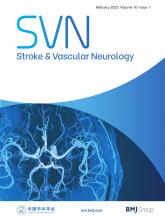Article Figures & Data
Tables
- Table 1
Sex differences in the epidemiology of spontaneous and traumatic cervical artery dissections, Olmsted County, 2002–2020
Female (n=68) Male (n=76) P Age at dissection, mean±SEM 47.3±2.0 52.5±1.8 0.0605 Race† 0.701 Asian 3 (4.4) 3 (3.9) Black/African American 1 (1.5) 0 (0) White 63 (92.6) 69 (90.8) Other 1 (1.5) 2 (2.6) Unknown/not reported 0 (0) 2 (2.6) Ethnicity† 0.371 Hispanic or Latina/o 0 (0) 2 (2.6) Not Hispanic or Latina/o 67 (98.5) 71 (93.4) Unknown/not reported 1 (1.5) 3 (3.9) Aetiology of dissection 0.341 Major trauma 7 (10.3) 14 (18.4) Minor trauma 13 (19.1) 11 (14.5) Spontaneous 48 (70.6) 51 (67.1) Location† 0.081 Common carotid 1 (1.5) 4 (5.3) Internal carotid 28 (41.2) 43 (56.6) Vertebral 36 (52.9) 28 (36.8) Both (carotid and vertebral) 3 (4.4) 1 (1.3) Medical comorbidities Migraine 38 (55.9) 12 (15.8) < 0.001** Hypertension 18 (26.5) 31 (40.8) 0.070 Hyperlipidaemia 18 (26.5) 33 (43.4) 0.034* Diabetes mellitus† 3 (4.5) 10 (13.2) 0.086 Smoking, current or history 25 (36.8) 33 (43.4) 0.416 Connective tissue disorder or fibromuscular dysplasia† 5 (7.4) 2 (2.6) 0.255 Presenting symptoms and signs Asymptomatic 10 (14.7) 13 (17.1) 0.695 Neck pain 27 (39.7) 16 (21.1) 0.015* Headache 31 (45.6) 37 (48.7) 0.710 Horner’s syndrome 11 (16.2) 8 (10.5) 0.317 Transient ischemic attack (TIA) 12 (17.6) 7 (9.2) 0.135 Stroke 18 (26.5) 32 (57.9) 0.049* Pulsatile tinnitus† 8 (11.8) 3 (3.9) 0.115 Dissection features Occlusion 14 (20.6) 22 (28.9) 0.247 Intramural haematoma 20 (29.4) 16 (21.1) 0.247 Dissecting pseudoaneurysm 21 (30.9) 13 (17.1) 0.052 Intraluminal thrombus† 1 (1.5) 5 (6.6) 0.126 Tapering off stenosis 16 (23.9) 26 (34.7) 0.160 Recurrent TIA/stroke† 3 (4.5) 7 (9.5) 0.332 Recurrent dissection† 8 (11.8) 1 (1.3) 0.013* mRS at 2 years† 0.403 0 33 (48.5) 26 (34.2) 1 22 (32.4) 27 (35.5) 2 4 (5.9) 9 (11.8) 3 2 (2.9) 4 (5.3) 4 6 (8.8) 6 (7.9) 5 0 (0) 0 (0) 6 1 (1.5) 4 (5.3) Values are represented as n (%) unless otherwise specified. Categorical variables were analysed using χ square or Fisher’s exact based on sample size. Continuous variables were analysed using unpaired t-test.
*p<0.05; **p<0.001.
†Fisher’s exact testing performed due to sample size.
mRS = modified Rankin Scale for neurologic disability; 0: no symptoms at all, 1: no significant disability despite symptoms; able to carry out all usual duties and activities, 2: slight disability; unable to carry out all previous activities, but able to look after own affairs without assistance, 3: moderate disability; requiring some help, but able to walk without assistance, 4: moderately severe disability; unable to walk and attend to bodily needs without assistance, 5: severe disability; bedridden, incontinent and requiring constant nursing care and attention, 6: dead.






